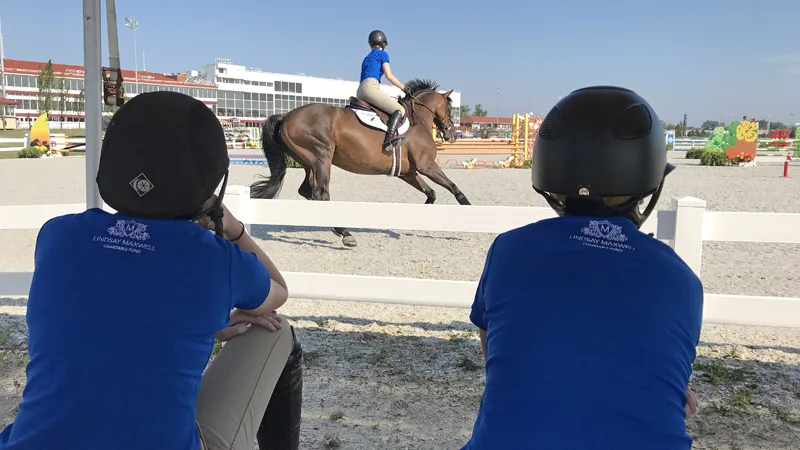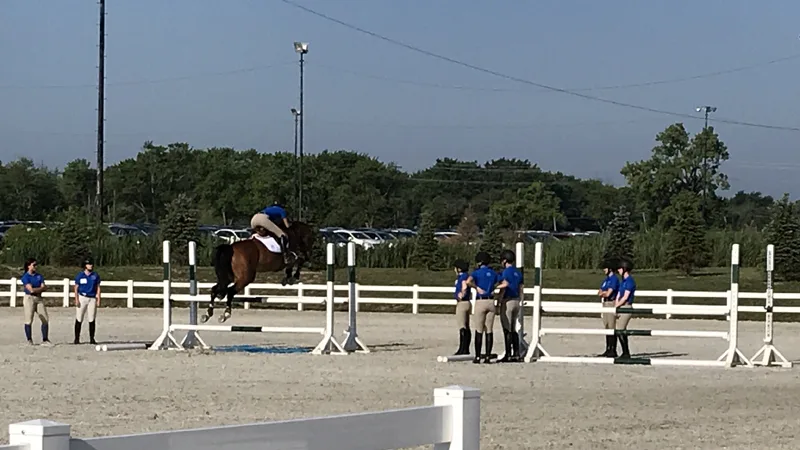As I write it’s the morning of the fifth and final day of the 2018 Chicago regional session of the USHJA’s Emerging Athletes Program. In front of me at HITS-Chicago sits a beautiful ring holding an elaborate course made up of brightly colored jumps. It’s a stark contrast from the plain white standards the riders have worked with all week. The layout of the course itself is the same as at all the regional clinics, but, USHJA rep Stacie Ryan tells me, she’s never seen one that looks as good as this one.
Behind me Anne Kursinski is in the warm-up ring preparing the first group of riders. There will be 21 of them in total, appearing in groups of three. They each get one shot at the course, followed by a critique from Anne, and then all that remains of the week is lunch, a closing meeting, and loading up the trailer for the trip home. Although I’m sure the clinicians have already formed solid impressions of each participant, for at least some of them a strong round would be a ticket to the EAP National Training Session.

When not riding or working in unmounted sessions, EAP participants were learning by watching. All photos courtesy of Chad Oldfather.
It’s not just that. Each of the participants has spent a week riding under the tutelage of an Olympian, and they will enter the ring after she has just warmed them up. Most have family here, and the other participants are looking on. There’s nervousness in the air.
In moments like these I think about coach Herb Brooks’ famous locker room speech to the 1980 Olympic “Miracle On Ice” U.S. hockey team before they played the Soviet Union. Tailored to the situation I’m in right now, it would go like this: “You were born to ride horses—every one of you. And you were meant to be here today. This is your time. Now go out there and take it!”
Three years ago [my older daughter] Ada and I were on our way to the first day of the 2015 Chicago regional session. The experience was bittersweet. We knew going in that this would be her last week with Cash, the horse with whom she more or less grew up as a rider. He seemed to sense something was up, throwing in bucks and other antics from time to time during the week, and on the final day, during the last round they ever had together, he attempted (but failed) to deposit her in a large puddle. But she rode well and came home with some very positive feedback from Chris Kappler. Watching this week has reminded me just how good they were together.
Watching [my younger daughter] Audrey this week has also been rewarding. I know how much time she puts into her riding day after day after day. Hearing an “excellent” or a “very good” or an “I love that, Audrey” from Anne Kursinski helps justify her time and mine. I know that she’s on a horse that was on stall rest for a solid week before the EAP as it recovered from a bruised foot, and I admire the graceful way she’s dealing with the bundle of unreleased energy beneath her. I feel more than a little proud when I overhear another parent, one who seems pretty knowledgeable, say nice things about her riding to someone else.
ADVERTISEMENT
My seat for the first several groups of riders has me facing the last jump. This week was tough, and nobody went without a struggle or two along the way. This course looks imposing. Yet one by one they tackle it, and their smiles after clearing the last fence are huge.
I ask Stacie Ryan why she does this. She’s the USHJA rep and unsung hero of the session, the person whose primary role is no less than making sure everything runs smoothly. She points to those very same smiles. Then she talks about the desire to give back to the sport that has given so much to her, and the joy of working with kids who have sought to be a part of the EAP because they want to learn. Anne Thornbury echoes this: “If there are kids who are willing to do something like this, then I should give back and teach them.”
Both Stacie and Anne make another point: The world nowadays isn’t set up to provide the same opportunities for a horse-crazy kid to hang out at the barn all day, every day like they each were able to do. The barn rat gig seems to be a little harder to fit into family schedules these days, and the learning that occurs through simply being around is harder to come by. The EAP represents an effort to fill in some of the gaps, for the good of the sport.
Sally Ike put it this way: “For me, the kids who are coming through the program now are our future professionals, and it’s important that we give them the best training (both riding and in the stables) that we can. If we don’t do it, who will?”

The USHJA Emerging Athletes Program gives juniors some of the skills they’ll need to become professional horsemen and women.
I’m sold. And I think it would be great if there was a way to realize Sally’s desire to develop programs at levels below and above the EAP, covering the basics at one and more advanced topics like how to run a business and how to deal with young horses at the other. There’s no real substitute for experience, of course, but there’s a lot to be said for a standard base from which to gain that experience.
Perhaps that will come to pass. In the meantime, I’ll close with two thoughts. The first is an expression of thanks. Both Audrey and I are grateful to the USHJA, the Lindsay Maxwell Charitable Fund, Anne Kursinski, Anne Thornbury, Stacie Ryan and DiAnn Langer for their roles in putting on such a valuable and tremendous clinic. Thanks as well to veterinarian Kyle Clarke for sharing his knowledge, and to Pat Boyle and HITS-Chicago for their first-class hosting.
The second is this. There’s an inherent tension in something like the EAP. It’s a learning opportunity, but it’s also a competition. It’s easy to focus on the latter, and to measure success by how the final round went, or whether one gets an invitation to nationals. And it’s easy to emphasize the portion of the learning that relates directly to being a more effective competitor in the future. There’s a lot to be said for Anne Kursinski’s advice to the riders that they should strive to “look like a winner” and constantly ask, “How can I be better?”
ADVERTISEMENT
“That’s what separates the winners,” she explained, “always trying to get better.” Unquestionably true.
But so, too, is what Anne Thornbury told me when I asked if she had any final thoughts to share: “Remember why you started. Too many people get hung up on winning, losing and competing. They forget why they started.”
Hard work and improvement are certainly laudable, and I like a blue ribbon as much as the next person. I’m hardly indifferent to the competition. But I also remember what turned out to be a prophetic moment at the Wisconsin State Fair when Ada was just a baby. We were taking her around the barns and found ourselves in an aisle of horses. It was almost certainly the first time Ada had seen a horse in person, and she was awestruck. I was a 30-something who had run off the farm for the city first chance he got, but in that moment something clicked for me.
“I had forgotten,” I said to my wife after a few moments peering into a stall, “just how majestic they are.”
Chad Oldfather is the blogging COTH Horse Dad. He’s the non-horsey father of two junior hunter/jumper/equitation riders, and he’s taking readers along on his horse show parenting journey. By day, he’s a law professor in Wisconsin, but on weekends and evenings, he can be found, laptop in hand, ringside at a lesson or show. Read his first blog, “My Soul For An Equitation Horse” to get to know him.
Read all of Chad’s COTH Horse Show Dad blogs for the Chronicle.














